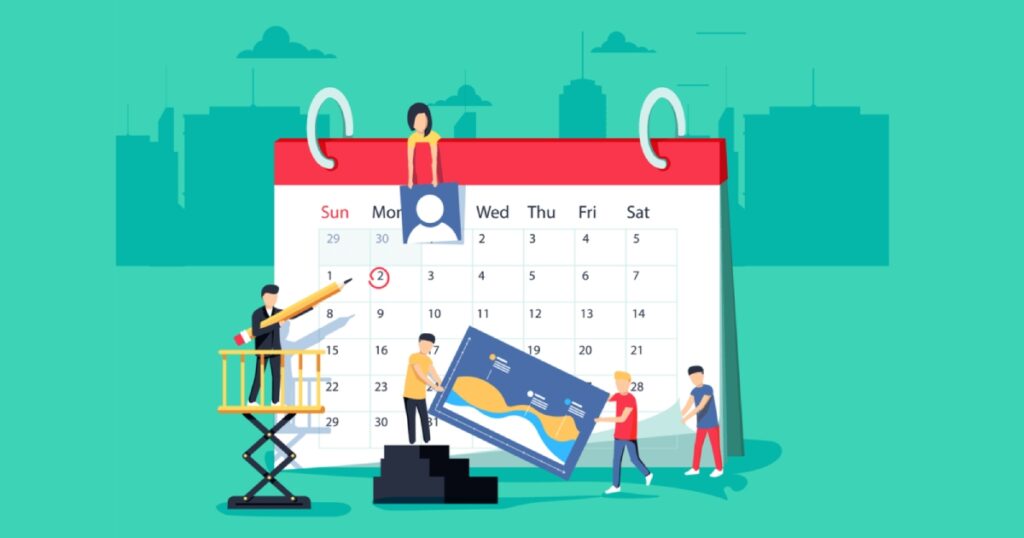Social media content calendars provide structure and direction for your social media efforts. They act as a roadmap, guiding you in creating and publishing high-quality content consistently. In this article, we will explore the importance of a social media content calendar and delve into the reasons why you need one.
What is a Social Media Content Calendar?
A social media content calendar is a strategic tool used by businesses and marketers to plan, organize, and schedule their social media content in a systematic manner. It serves as a blueprint for creating and distributing engaging and relevant content across various social media platforms.
A social media content calendar offers a structured approach to managing social media content by providing a visual overview of planned posts, campaigns, and important dates. It allows businesses to streamline their content creation process, maintain consistency in messaging, and maximize the impact of their social media efforts.
Reasons to Have a Social Media Content Calendar

Improved Organization and Planning
A social media content calendar provides structure and organization to your social media marketing efforts. By having a centralized calendar, you can plan and schedule your content in advance, ensuring a consistent and strategic approach to your social media presence. It helps you stay organized by providing a visual overview of your planned content, allowing you to manage and allocate resources efficiently.
Consistency in Messaging and Branding
Maintaining consistency in your messaging and branding is crucial for building a strong and recognizable brand identity. A content calendar allows you to plan your content in a way that aligns with your brand guidelines and tone of voice. This consistency helps to reinforce your brand image and establish trust and familiarity with your audience.
Time Efficiency and Productivity
Planning your social media content in advance saves you time and allows for better time management. With a content calendar, you can batch-create content, schedule posts ahead of time, and automate the publishing process. This frees up valuable time that can be spent engaging with your audience, analyzing performance, and strategizing for future campaigns.
Strategic Content Planning
A content calendar enables you to plan your content around important dates, events, and campaigns. By aligning your content with relevant holidays, industry trends, or product launches, you can capitalize on timely opportunities and maximize your reach and engagement. This strategic planning helps you stay ahead of your competition and ensures that your content remains relevant and engaging.
Improved Collaboration and Teamwork
A content calendar serves as a central reference point for your team, fostering collaboration and ensuring everyone is on the same page. It allows different team members involved in content creation and social media management to coordinate their efforts, assign tasks, and meet deadlines. This collaborative approach improves efficiency, minimizes errors, and encourages teamwork.
Audience Engagement and Value Delivery
A well-planned content calendar helps you deliver valuable and engaging content to your audience consistently. By understanding your target audience and their preferences, you can create content that resonates with them, addresses their pain points, and provides solutions or entertainment. This targeted approach increases audience engagement, encourages sharing, and builds a loyal community around your brand.
Performance Tracking and Optimization
A content calendar provides a historical record of your social media content, allowing you to track and analyze its performance. By monitoring metrics such as reach, engagement, and conversions, you can gain insights into what works best for your audience. This data-driven approach enables you to optimize your future content strategies, refine your messaging, and continuously improve your social media performance.
How to Create a Social Media Content Calendar

Creating a social media content calendar is essential for the effective planning and organization of your social media marketing efforts. Here are the key steps to help you create a well-structured and strategic content calendar:
Define Your Objectives and Target Audience
Before diving into creating a content calendar, it’s crucial to clarify your objectives and identify your target audience. Determine what you want to achieve with your social media presence, whether it’s increasing brand awareness, driving website traffic, or generating leads. Understanding your target audience’s demographics, interests, and preferences will help you tailor your content to their needs and interests.
Choose the Right Tools
Selecting the right tools to create and manage your content calendar is essential for efficient planning and scheduling. There are various options available, including spreadsheet software like Excel or Google Sheets, project management tools like Trello or Asana, or specialized social media management platforms like Hootsuite or Buffer. Choose a tool that suits your needs and enables easy collaboration and scheduling.
Determine Content Categories and Themes
To ensure a diverse and engaging content mix, define content categories and themes that align with your brand and resonate with your audience. For example, you may have categories such as educational posts, behind-the-scenes content, user-generated content, promotional offers, or industry news. Assigning specific themes to different days or weeks can add variety and help guide your content creation process.
Create a Content Calendar Template
Design a content calendar template that suits your needs and preferences. You can use a monthly or weekly calendar format, depending on your posting frequency and content volume. Include columns for the date, content category, social media platform, post caption, and any other relevant information. A template provides a structured framework for planning and organizing your content in a visually appealing and easy-to-follow manner.
Plan Your Content in Advance
With your content calendar template ready, start filling it in with planned content. Research upcoming events, holidays, and industry trends that are relevant to your brand, and incorporate them into your calendar. Plan your content at least a month in advance to allow time for content creation, review, and revisions. Be flexible and leave room for spontaneous posts or timely updates to keep your content fresh and relevant.
Optimize Posting Frequency and Timing
Consider your audience’s behavior and the optimal posting frequency and timing for each social media platform. Experiment with different posting schedules and track engagement metrics to determine when your audience is most active and responsive. This data-driven approach will help you optimize your posting strategy and maximize the impact of your content.
Engage and Interact with Your Audience
A content calendar is not just about scheduling posts; it’s also about fostering engagement and building relationships with your audience. Set aside time each day to monitor and respond to comments, messages, and mentions. Engage in conversations, ask questions, and encourage user-generated content to create a sense of community and loyalty around your brand.
Evaluate and Refine Your Strategy
Regularly assess the performance of your social media content and evaluate the effectiveness of your content calendar. Analyze metrics such as reach, engagement, click-through rates, and conversions to identify trends and areas for improvement. Use these insights to refine your content strategy, experiment with new approaches, and continuously optimize your social media presence.
By following these steps, you can create a well-structured and strategic social media content calendar that aligns with your objectives, engages your audience, and helps you achieve your marketing goals.
A social media content calendar is a powerful tool that can significantly enhance your social media marketing efforts. Providing structure, organization, and consistency, it enables you to engage your audience effectively and achieve your marketing goals. Embrace the benefits of a social media content calendar and take your social media strategy to new heights.
FAQs
A social media content calendar can benefit your small business in several ways. It helps you stay organized, save time, maintain consistency, plan engaging content, optimize posting times, coordinate marketing campaigns, and collaborate with team members. By utilizing a content calendar, you can streamline your social media efforts and drive better results for your business.
The planning horizon for social media content can vary depending on your business and industry. However, it is generally recommended to plan at least one month in advance. This allows you to have a holistic view of your content strategy and make any necessary adjustments based on upcoming events, trends, or changes in your business.
Yes, there are several free tools available that can help you create and manage your social media content calendar. Some popular options include Google Sheets, Trello, Asana, and Buffer. These tools offer customizable templates and features to help you plan, schedule, and analyze your social media posts effectively.
Your social media content calendar should be a dynamic and evolving document. It is important to update it regularly to reflect any changes in your business, industry trends, or new content ideas. Review and update your calendar at least once a week to ensure that it remains relevant and aligned with your overall marketing strategy.
Yes, a social media content calendar can help you track your performance. By analyzing the engagement, reach, and conversions generated from your social media posts, you can gain insights into what content resonates with your audience and what strategies are most effective. This data can guide future content decisions and optimize your social media marketing efforts.
If your social media content calendar is not generating the desired results, it is essential to analyze and identify the areas that need improvement. Consider reviewing your content strategy, analyzing your target audience, experimenting with different types of content, or revisiting your posting frequency and timing. It may also be helpful to seek advice from social media marketing professionals or conduct A/B testing to optimize your approach.
Related articles
 Anas is our go-to copywriter with a knack for crafting persuasive and high-converting eCommerce landing pages. His passion for words and understanding of consumer psychology helps turn visitors into loyal customers. When he's not refining his copy, Anas enjoys exploring the latest digital marketing trends and experimenting with new writing techniques. His blend of creativity and strategic thinking makes him an indispensable part of our energetic team.
Anas is our go-to copywriter with a knack for crafting persuasive and high-converting eCommerce landing pages. His passion for words and understanding of consumer psychology helps turn visitors into loyal customers. When he's not refining his copy, Anas enjoys exploring the latest digital marketing trends and experimenting with new writing techniques. His blend of creativity and strategic thinking makes him an indispensable part of our energetic team.












